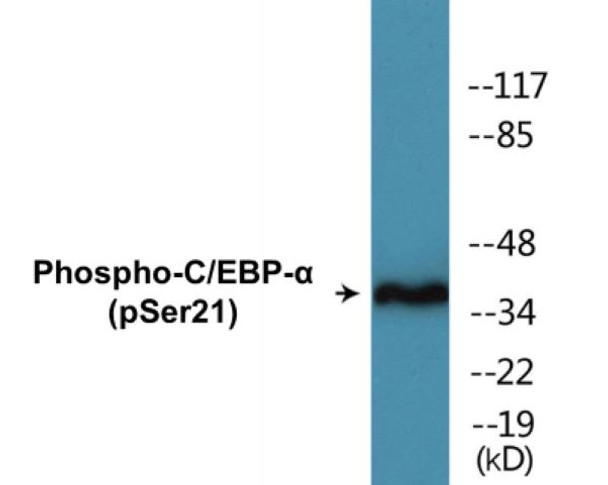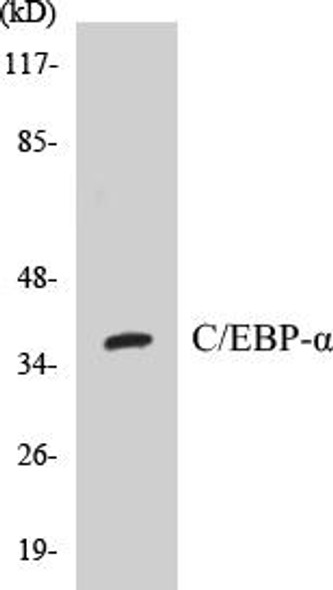Description
C/EBP-alpha (Phospho-Ser21)Colorimetric Cell-Based ELISA Kit
The C/EBP alpha Phospho-Ser21 Colorimetric Cell-Based ELISA Kit is specifically designed for the precise measurement of C/EBP alpha levels in cell lysates. With its high sensitivity and specificity, this kit ensures accurate and reproducible results, making it an ideal tool for studying the role of C/EBP alpha in various cell signaling pathways.C/EBP alpha is a crucial transcription factor that plays a key role in regulating gene expression and cell differentiation.
Phosphorylation of C/EBP alpha at Ser21 is known to modulate its activity, making it a valuable target for research in fields such as cancer, inflammation, and metabolism.By utilizing this innovative kit, researchers can gain valuable insights into the complex mechanisms underlying cellular processes and disease development, ultimately leading to the development of targeted therapies and personalized treatment strategies.
| Product Name: | C/EBP-alpha (Phospho-Ser21)Colorimetric Cell-Based ELISA Kit |
| Product Code: | CBCAB01231 |
| ELISA Type: | Cell-Based |
| Target: | C/EBP-alpha (Phospho-Ser21) |
| Reactivity: | Human, Mouse, Rat |
| Dynamic Range: | > 5000 Cells |
| Detection Method: | Colorimetric 450 nm |
| Format: | 2 x 96-Well Microplates |
The C/EBP-alpha (Phospho-Ser21) Colorimetric Cell-Based ELISA Kit is a convenient, lysate-free, high throughput and sensitive assay kit that can detect C/EBP-alpha protein phosphorylation and expression profile in cells. The kit can be used for measuring the relative amounts of phosphorylated C/EBP-alpha in cultured cells as well as screening for the effects that various treatments, inhibitors (ie. siRNA or chemicals), or activators have on C/EBP-alpha phosphorylation.
Qualitative determination of C/EBP-alpha (Phospho-Ser21) concentration is achieved by an indirect ELISA format. In essence, C/EBP-alpha (Phospho-Ser21) is captured by C/EBP-alpha (Phospho-Ser21)-specific primary (1ø) antibodies while the HRP-conjugated secondary (2ø) antibodies bind the Fc region of the 1ø antibody. Through this binding, the HRP enzyme conjugated to the 2ø antibody can catalyze a colorimetric reaction upon substrate addition. Due to the qualitative nature of the Cell-Based ELISA, multiple normalization methods are needed:
| 1. | A monoclonal antibody specific for human GAPDH is included to serve as an internal positive control in normalizing the target absorbance values. |
| 2. | Following the colorimetric measurement of HRP activity via substrate addition, the Crystal Violet whole-cell staining method may be used to determine cell density. After staining, the results can be analysed by normalizing the absorbance values to cell amounts, by which the plating difference can be adjusted. |
| Database Information: | Gene ID: 1050, UniProt ID: P49715, OMIM: 116897, Unigene: Hs.699463 |
| Gene Symbol: | CEBPA |
| Sub Type: | Phospho |
| UniProt Protein Function: | C/EBP-alpha: a bZIP transcription factor which can form homodimers or heterodimers with the related proteins CEBP-beta and CEBP-gamma. Binds to the promoter and modulate the expression of the gene encoding leptin, a protein that plays an important role in body weight homeostasis. Can interact with CDK2 and CDK4, thereby inhibiting these kinases and causing growth arrest in cultured cells. |
| UniProt Protein Details: | Protein type:DNA-binding; Transcription factor Chromosomal Location of Human Ortholog: 19q13.1 Cellular Component: Rb-E2F complex; nuclear matrix; nucleus Molecular Function:RNA polymerase II transcription factor activity, enhancer binding; protein binding; protein homodimerization activity; DNA binding; protein heterodimerization activity; protein complex binding; transcription factor activity; transcription factor binding Biological Process: transcription from RNA polymerase II promoter; fat cell differentiation; embryonic placenta development; macrophage differentiation; viral reproduction; cell maturation; response to glucocorticoid stimulus; negative regulation of transcription from RNA polymerase II promoter; glucose homeostasis; negative regulation of cell proliferation; response to vitamin B2; acute-phase response; inner ear development; cholesterol metabolic process; mitochondrion organization and biogenesis; generation of precursor metabolites and energy; organ regeneration; granulocyte differentiation; transcription, DNA-dependent; cytokine and chemokine mediated signaling pathway; negative regulation of cyclin-dependent protein kinase activity; liver development; positive regulation of osteoblast differentiation; positive regulation of proteasomal ubiquitin-dependent protein catabolic process; white fat cell differentiation; brown fat cell differentiation; positive regulation of fat cell differentiation; positive regulation of transcription from RNA polymerase III promoter; myeloid cell differentiation; positive regulation of transcription from RNA polymerase II promoter; urea cycle; lung development Disease: Leukemia, Acute Myeloid |
| NCBI Summary: | This intronless gene encodes a transcription factor that contains a basic leucine zipper (bZIP) domain and recognizes the CCAAT motif in the promoters of target genes. The encoded protein functions in homodimers and also heterodimers with CCAAT/enhancer-binding proteins beta and gamma. Activity of this protein can modulate the expression of genes involved in cell cycle regulation as well as in body weight homeostasis. Mutation of this gene is associated with acute myeloid leukemia. The use of alternative in-frame non-AUG (GUG) and AUG start codons results in protein isoforms with different lengths. Differential translation initiation is mediated by an out-of-frame, upstream open reading frame which is located between the GUG and the first AUG start codons. [provided by RefSeq, Dec 2013] |
| UniProt Code: | P49715 |
| NCBI GenInfo Identifier: | 166898082 |
| NCBI Gene ID: | 1050 |
| NCBI Accession: | P49715.3 |
| UniProt Secondary Accession: | P49715,P78319, Q05CA4, A7LNP2, |
| UniProt Related Accession: | P49715 |
| Molecular Weight: | 37,561 Da |
| NCBI Full Name: | CCAAT/enhancer-binding protein alpha |
| NCBI Synonym Full Names: | CCAAT/enhancer binding protein (C/EBP), alpha |
| NCBI Official Symbol: | CEBPA |
| NCBI Official Synonym Symbols: | CEBP; C/EBP-alpha |
| NCBI Protein Information: | CCAAT/enhancer-binding protein alpha |
| UniProt Protein Name: | CCAAT/enhancer-binding protein alpha |
| Protein Family: | CCAAT/enhancer-binding protein |
| UniProt Gene Name: | CEBPA |
| UniProt Entry Name: | CEBPA_HUMAN |
| Component | Quantity |
| 96-Well Cell Culture Clear-Bottom Microplate | 2 plates |
| 10X TBS | 24 mL |
| Quenching Buffer | 24 mL |
| Blocking Buffer | 50 mL |
| 15X Wash Buffer | 50 mL |
| Primary Antibody Diluent | 12 mL |
| 100x Anti-Phospho Target Antibody | 60 µL |
| 100x Anti-Target Antibody | 60 µL |
| Anti-GAPDH Antibody | 60 µL |
| HRP-Conjugated Anti-Rabbit IgG Antibody | 12 mL |
| HRP-Conjugated Anti-Mouse IgG Antibody | 12 mL |
| SDS Solution | 12 mL |
| Stop Solution | 24 mL |
| Ready-to-Use Substrate | 12 mL |
| Crystal Violet Solution | 12 mL |
| Adhesive Plate Seals | 2 seals |
The following materials and/or equipment are NOT provided in this kit but are necessary to successfully conduct the experiment:
- Microplate reader able to measure absorbance at 450 nm and/or 595 nm for Crystal Violet Cell Staining (Optional)
- Micropipettes with capability of measuring volumes ranging from 1 µL to 1 ml
- 37% formaldehyde (Sigma Cat# F-8775) or formaldehyde from other sources
- Squirt bottle, manifold dispenser, multichannel pipette reservoir or automated microplate washer
- Graph paper or computer software capable of generating or displaying logarithmic functions
- Absorbent papers or vacuum aspirator
- Test tubes or microfuge tubes capable of storing ≥1 ml
- Poly-L-Lysine (Sigma Cat# P4832 for suspension cells)
- Orbital shaker (optional)
- Deionized or sterile water
*Note: Protocols are specific to each batch/lot. For the correct instructions please follow the protocol included in your kit.
| Step | Procedure |
| 1. | Seed 200 µL of 20,000 adherent cells in culture medium in each well of a 96-well plate. The plates included in the kit are sterile and treated for cell culture. For suspension cells and loosely attached cells, coat the plates with 100 µL of 10 µg/ml Poly-L-Lysine (not included) to each well of a 96-well plate for 30 minutes at 37 °C prior to adding cells. |
| 2. | Incubate the cells for overnight at 37 °C, 5% CO2. |
| 3. | Treat the cells as desired. |
| 4. | Remove the cell culture medium and rinse with 200 µL of 1x TBS, twice. |
| 5. | Fix the cells by incubating with 100 µL of Fixing Solution for 20 minutes at room temperature. The 4% formaldehyde is used for adherent cells and 8% formaldehyde is used for suspension cells and loosely attached cells. |
| 6. | Remove the Fixing Solution and wash the plate 3 times with 200 µL 1x Wash Buffer for five minutes each time with gentle shaking on the orbital shaker. The plate can be stored at 4 °C for a week. |
| 7. | Add 100 µL of Quenching Buffer and incubate for 20 minutes at room temperature. |
| 8. | Wash the plate 3 times with 1x Wash Buffer for 5 minutes each time. |
| 9. | Add 200 µL of Blocking Buffer and incubate for 1 hour at room temperature. |
| 10. | Wash 3 times with 200 µL of 1x Wash Buffer for 5 minutes each time. |
| 11. | Add 50 µL of 1x primary antibodies Anti-C/EBP-alpha (Phospho-Ser21) Antibody, Anti-C/EBP-alpha Antibody and/or Anti-GAPDH Antibody) to the corresponding wells, cover with Parafilm and incubate for 16 hours (overnight) at 4 °C. If the target expression is known to be high, incubate for 2 hours at room temperature. |
| 12. | Wash 3 times with 200 µL of 1x Wash Buffer for 5 minutes each time. |
| 13. | Add 50 µL of 1x secondary antibodies (HRP-Conjugated AntiRabbit IgG Antibody or HRP-Conjugated Anti-Mouse IgG Antibody) to corresponding wells and incubate for 1.5 hours at room temperature. |
| 14. | Wash 3 times with 200 µL of 1x Wash Buffer for 5 minutes each time. |
| 15. | Add 50 µL of Ready-to-Use Substrate to each well and incubate for 30 minutes at room temperature in the dark. |
| 16. | Add 50 µL of Stop Solution to each well and read OD at 450 nm immediately using the microplate reader. |
(Additional Crystal Violet staining may be performed if desired – details of this may be found in the kit technical manual.)






